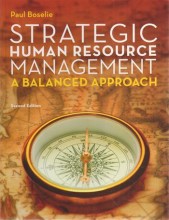Summary: Organization And Society
- This + 400k other summaries
- A unique study and practice tool
- Never study anything twice again
- Get the grades you hope for
- 100% sure, 100% understanding
Read the summary and the most important questions on Organization and society
-
1 Organisations in a society
This is a preview. There are 1 more flashcards available for chapter 1
Show more cards here -
There is an interdependence between organizations and society in which maneuvering of organizations in society can be understood as a two way process. In which ways can designers contribute to society?
By either choosing to incorporate specific societal programs in the organization or by either choosing to incorporate specific programs into society. -
1.2.1 Globalisation
This is a preview. There are 4 more flashcards available for chapter 1.2.1
Show more cards here -
What is Stiglitz view on globalization? Refer to the benefits and drawbacks.
Benefits:
- Free flow of capital and goods
- Knowledge sharing
- Technology
Drawbacks:
- Wealth flow from poor to rich countries
- Undesirable conditions due to which developing countries cannot develop.
- In sum: the developed countries benefit over the developing countries. -
1.2.2 Capitalism
This is a preview. There are 1 more flashcards available for chapter 1.2.2
Show more cards here -
Elaborate on Freeman's view of capitalism.
Freeman arguesorganizations should createshared value inorder to createwin-win situations and benefit fromcapitalism . In hisshareholder perspective, theethical stance should be considered regarding what's good for society. A free market cannot take care of this. Hedeveloped 6 principles:
1. The principle ofstakeholder cooperation
2. Principle ofstakeholder engagement
3. Stakeholderresponsibility ;willingness toaccept responsibility for the consequences of theiractions
4. Principle ofcomplexity
5.Continuous creation
6.Emergent competition -
What's the difference between the ground of principle an the ground of consequence, as argued by Friedman?
Ground of principle; responsibility questions should be covered by political mechanisms.
Ground of consequence; question whether corporate executives can discharge social responsibility: how does he know when he's responsible? Managers are an expert in doing business, not in saving the world. -
2 The underpinnings of society
This is a preview. There are 1 more flashcards available for chapter 2
Show more cards here -
What is the balancing act as argued by van Staveren?
This is the balance between how to do good if you have not enough resources; gain economic value AND being meaningful. -
2.1 Achterberg & Vriens - Concept of incorporation
This is a preview. There are 3 more flashcards available for chapter 2.1
Show more cards here -
Achterberg & Vriens described four modes of incorporation by which organizations incorporate societal programs into their decision making and premises. Which 2 destinations are made in this model?
They make a distinction between instrumental (isolating) and responsible/inclusive (integrity) and between incorporation of societal programs and incorporation beyond societal programs.
Instrumental: incorporation of societal programs because you benefit from it or it gives you costs when you don't do it (costs can also be reputation).
Responsible/inclusive (integrity); you do societal programs because you think it's the right thing to do.
Incorporation of societal programs; you stick to what's mandatory/required and you don't do things on your own initiative.
Incorporation beyond societal programs; you go beyond the mandatory societal programs -
What are the benefits and limitations of the incorporation model of Achterberg and Vriens?
Benefits: it's a tool to reflect on complexity of discourse on organization responsibility. It makes a distinction between what we see and what organizations do. So, distinction between intention and action.
Limitation: you're not sure why organizations contribute to the mandatory rules. E.g. Greenwashing. -
2.2 Philospohical traditions
-
When organizations choose how to incorporate society in their organization (choosing how they select, interpret and integrate) they also make a decision that is underpinned by deeper motivation. Why do organizations have certain underpinnings? (hint; prescriptive and descriptive)
These underpinnings are the philosophical traditions which are prescriptive and descriptive. It's about what should someone do and what do people believe to be right? -
Why are values and facts intertwined?
Values and facts are intertwined because in social science, values and interaction influence our understanding of the world.
"The good life is embedded in social practices" -
2.2.1 Utilitarianism
This is a preview. There are 3 more flashcards available for chapter 2.2.1
Show more cards here -
How do you come to the correct moral decision according to utilitarianism?
1. Assess the positive consequences
2. Assess the negative consequences
3. Assess the overall price
4. Choose the highest utility (so, choice with the lowest costs).
- Higher grades + faster learning
- Never study anything twice
- 100% sure, 100% understanding
Topics related to Summary: Organization And Society
-
The underpinnings of society - Philospohical traditions
-
Corporate social responsibility - CSR as value creation - business case
-
Stakeholder theory - Stakeholder perspective
-
Stakeholder theory - Political perspective
-
Institutional theory - Legitimacy
-
Institutional theory - Decoupling
-
Designers perspective - Organizational focus - Step by step model
-
Designers perspective - Societal focus

































